University Health Project: Primary Healthcare in Action Report
VerifiedAdded on 2023/01/19
|7
|1809
|37
Report
AI Summary
This report examines a primary healthcare project focused on an Australian Indigenous community, addressing four key questions. The report identifies and discusses two social determinants of health, specifically education and social interactions, highlighting programs designed to support teenage mothers and involve fathers in parenting. It then analyzes two primary healthcare principles: local indigenous community engagement and collaborative approaches, illustrating how these principles guided the project through collaboration with community members and various organizations. The report also explores a strategy from the Ottawa Charter for health promotion, enabling, demonstrating how the project fostered community healing and empowered individuals through safe spaces and supportive activities. Finally, it discusses the importance of cultural competence in healthcare, emphasizing how respecting the cultural beliefs and practices of the Kalumburu community facilitated the project's success and fostered trust and collaboration.
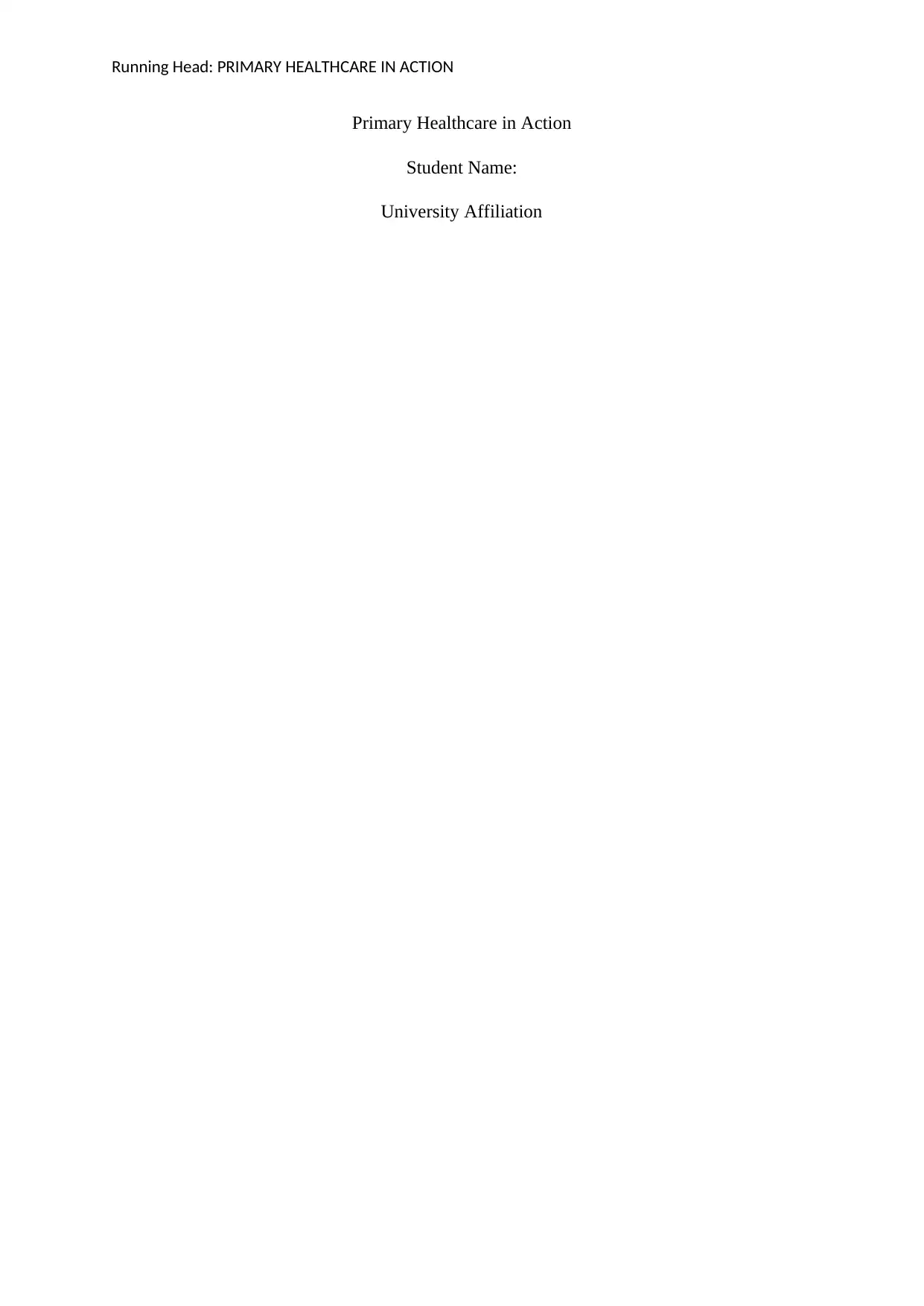
Running Head: PRIMARY HEALTHCARE IN ACTION
Primary Healthcare in Action
Student Name:
University Affiliation
Primary Healthcare in Action
Student Name:
University Affiliation
Paraphrase This Document
Need a fresh take? Get an instant paraphrase of this document with our AI Paraphraser
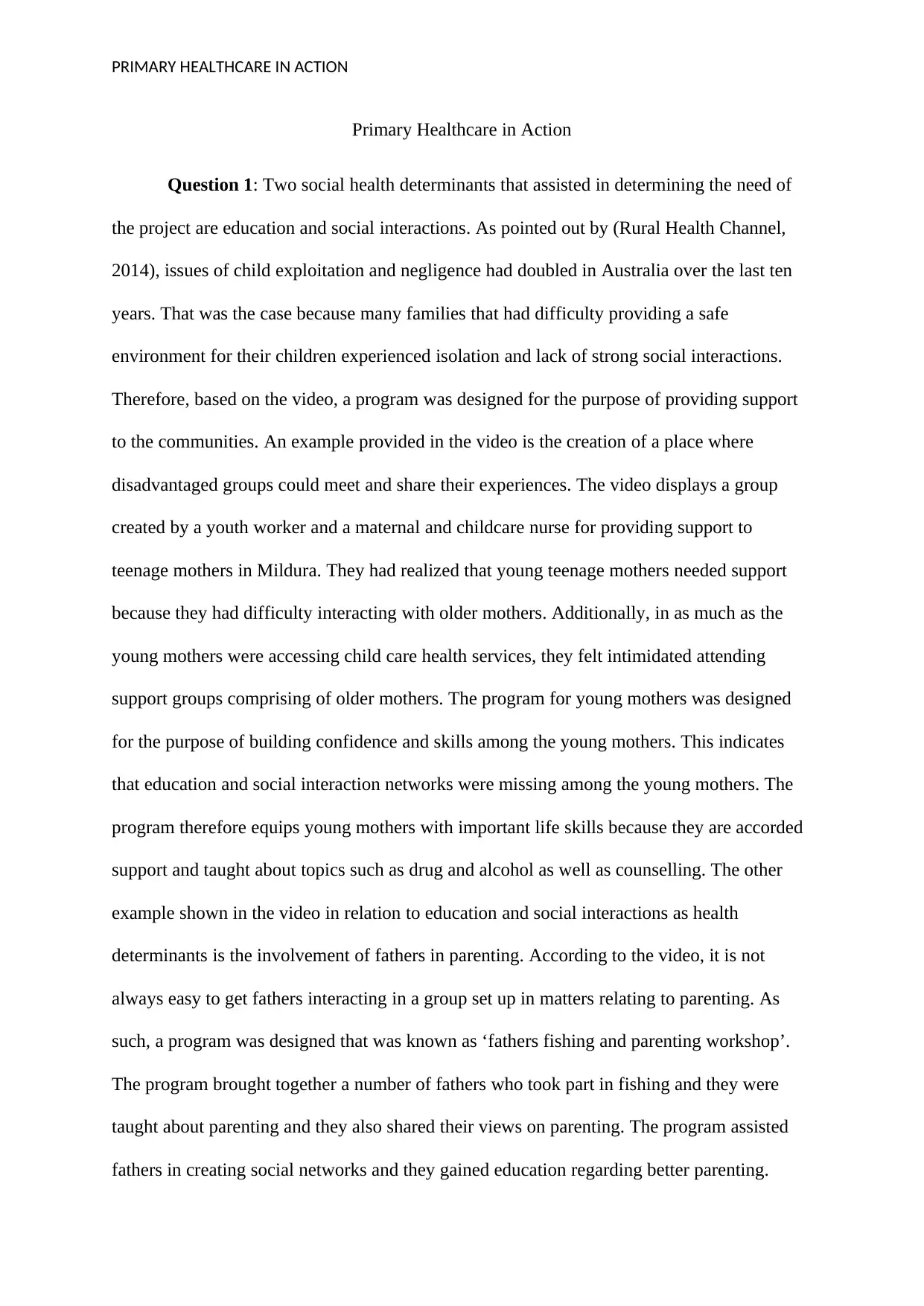
PRIMARY HEALTHCARE IN ACTION
Primary Healthcare in Action
Question 1: Two social health determinants that assisted in determining the need of
the project are education and social interactions. As pointed out by (Rural Health Channel,
2014), issues of child exploitation and negligence had doubled in Australia over the last ten
years. That was the case because many families that had difficulty providing a safe
environment for their children experienced isolation and lack of strong social interactions.
Therefore, based on the video, a program was designed for the purpose of providing support
to the communities. An example provided in the video is the creation of a place where
disadvantaged groups could meet and share their experiences. The video displays a group
created by a youth worker and a maternal and childcare nurse for providing support to
teenage mothers in Mildura. They had realized that young teenage mothers needed support
because they had difficulty interacting with older mothers. Additionally, in as much as the
young mothers were accessing child care health services, they felt intimidated attending
support groups comprising of older mothers. The program for young mothers was designed
for the purpose of building confidence and skills among the young mothers. This indicates
that education and social interaction networks were missing among the young mothers. The
program therefore equips young mothers with important life skills because they are accorded
support and taught about topics such as drug and alcohol as well as counselling. The other
example shown in the video in relation to education and social interactions as health
determinants is the involvement of fathers in parenting. According to the video, it is not
always easy to get fathers interacting in a group set up in matters relating to parenting. As
such, a program was designed that was known as ‘fathers fishing and parenting workshop’.
The program brought together a number of fathers who took part in fishing and they were
taught about parenting and they also shared their views on parenting. The program assisted
fathers in creating social networks and they gained education regarding better parenting.
Primary Healthcare in Action
Question 1: Two social health determinants that assisted in determining the need of
the project are education and social interactions. As pointed out by (Rural Health Channel,
2014), issues of child exploitation and negligence had doubled in Australia over the last ten
years. That was the case because many families that had difficulty providing a safe
environment for their children experienced isolation and lack of strong social interactions.
Therefore, based on the video, a program was designed for the purpose of providing support
to the communities. An example provided in the video is the creation of a place where
disadvantaged groups could meet and share their experiences. The video displays a group
created by a youth worker and a maternal and childcare nurse for providing support to
teenage mothers in Mildura. They had realized that young teenage mothers needed support
because they had difficulty interacting with older mothers. Additionally, in as much as the
young mothers were accessing child care health services, they felt intimidated attending
support groups comprising of older mothers. The program for young mothers was designed
for the purpose of building confidence and skills among the young mothers. This indicates
that education and social interaction networks were missing among the young mothers. The
program therefore equips young mothers with important life skills because they are accorded
support and taught about topics such as drug and alcohol as well as counselling. The other
example shown in the video in relation to education and social interactions as health
determinants is the involvement of fathers in parenting. According to the video, it is not
always easy to get fathers interacting in a group set up in matters relating to parenting. As
such, a program was designed that was known as ‘fathers fishing and parenting workshop’.
The program brought together a number of fathers who took part in fishing and they were
taught about parenting and they also shared their views on parenting. The program assisted
fathers in creating social networks and they gained education regarding better parenting.
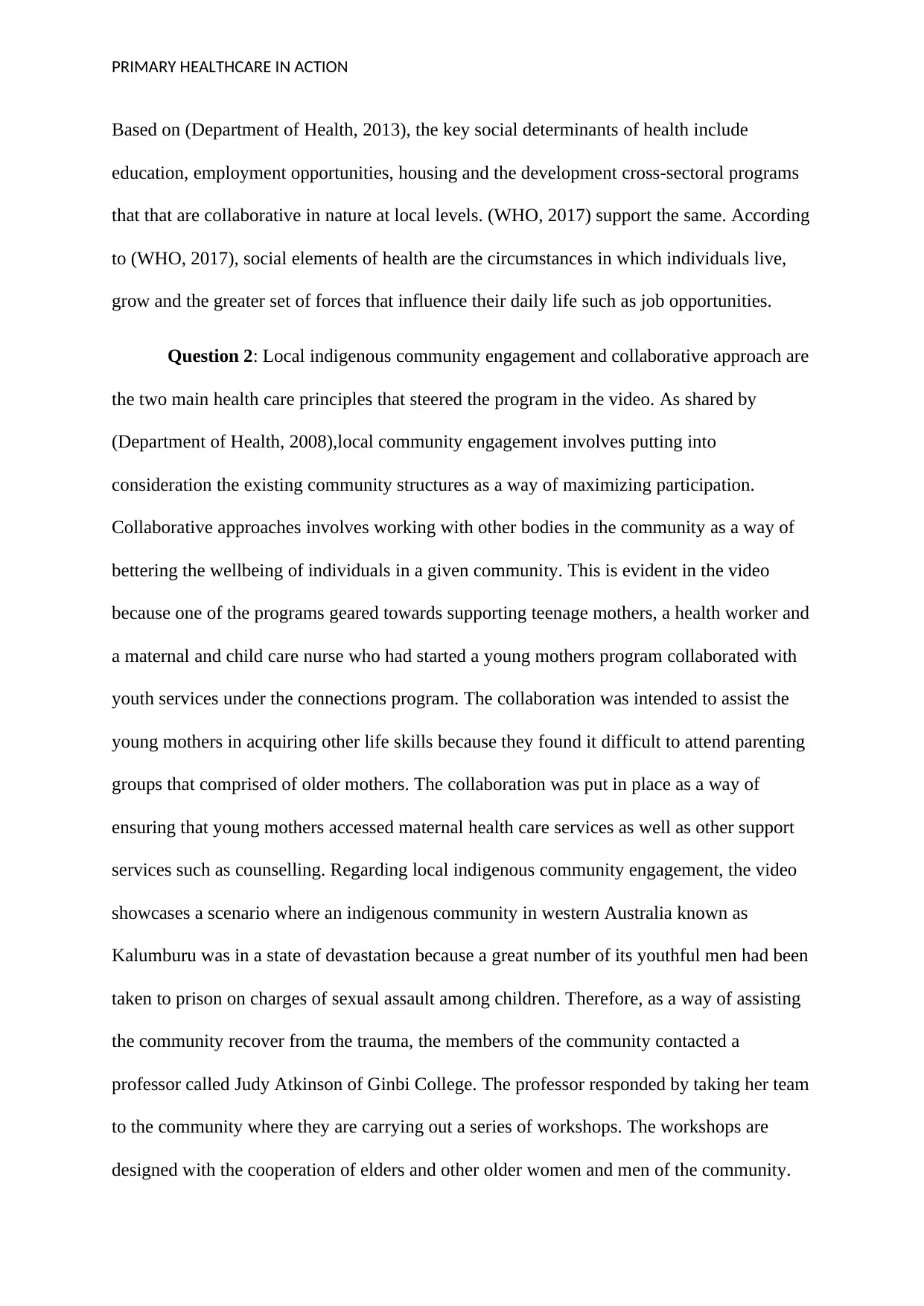
PRIMARY HEALTHCARE IN ACTION
Based on (Department of Health, 2013), the key social determinants of health include
education, employment opportunities, housing and the development cross-sectoral programs
that that are collaborative in nature at local levels. (WHO, 2017) support the same. According
to (WHO, 2017), social elements of health are the circumstances in which individuals live,
grow and the greater set of forces that influence their daily life such as job opportunities.
Question 2: Local indigenous community engagement and collaborative approach are
the two main health care principles that steered the program in the video. As shared by
(Department of Health, 2008),local community engagement involves putting into
consideration the existing community structures as a way of maximizing participation.
Collaborative approaches involves working with other bodies in the community as a way of
bettering the wellbeing of individuals in a given community. This is evident in the video
because one of the programs geared towards supporting teenage mothers, a health worker and
a maternal and child care nurse who had started a young mothers program collaborated with
youth services under the connections program. The collaboration was intended to assist the
young mothers in acquiring other life skills because they found it difficult to attend parenting
groups that comprised of older mothers. The collaboration was put in place as a way of
ensuring that young mothers accessed maternal health care services as well as other support
services such as counselling. Regarding local indigenous community engagement, the video
showcases a scenario where an indigenous community in western Australia known as
Kalumburu was in a state of devastation because a great number of its youthful men had been
taken to prison on charges of sexual assault among children. Therefore, as a way of assisting
the community recover from the trauma, the members of the community contacted a
professor called Judy Atkinson of Ginbi College. The professor responded by taking her team
to the community where they are carrying out a series of workshops. The workshops are
designed with the cooperation of elders and other older women and men of the community.
Based on (Department of Health, 2013), the key social determinants of health include
education, employment opportunities, housing and the development cross-sectoral programs
that that are collaborative in nature at local levels. (WHO, 2017) support the same. According
to (WHO, 2017), social elements of health are the circumstances in which individuals live,
grow and the greater set of forces that influence their daily life such as job opportunities.
Question 2: Local indigenous community engagement and collaborative approach are
the two main health care principles that steered the program in the video. As shared by
(Department of Health, 2008),local community engagement involves putting into
consideration the existing community structures as a way of maximizing participation.
Collaborative approaches involves working with other bodies in the community as a way of
bettering the wellbeing of individuals in a given community. This is evident in the video
because one of the programs geared towards supporting teenage mothers, a health worker and
a maternal and child care nurse who had started a young mothers program collaborated with
youth services under the connections program. The collaboration was intended to assist the
young mothers in acquiring other life skills because they found it difficult to attend parenting
groups that comprised of older mothers. The collaboration was put in place as a way of
ensuring that young mothers accessed maternal health care services as well as other support
services such as counselling. Regarding local indigenous community engagement, the video
showcases a scenario where an indigenous community in western Australia known as
Kalumburu was in a state of devastation because a great number of its youthful men had been
taken to prison on charges of sexual assault among children. Therefore, as a way of assisting
the community recover from the trauma, the members of the community contacted a
professor called Judy Atkinson of Ginbi College. The professor responded by taking her team
to the community where they are carrying out a series of workshops. The workshops are
designed with the cooperation of elders and other older women and men of the community.
⊘ This is a preview!⊘
Do you want full access?
Subscribe today to unlock all pages.

Trusted by 1+ million students worldwide
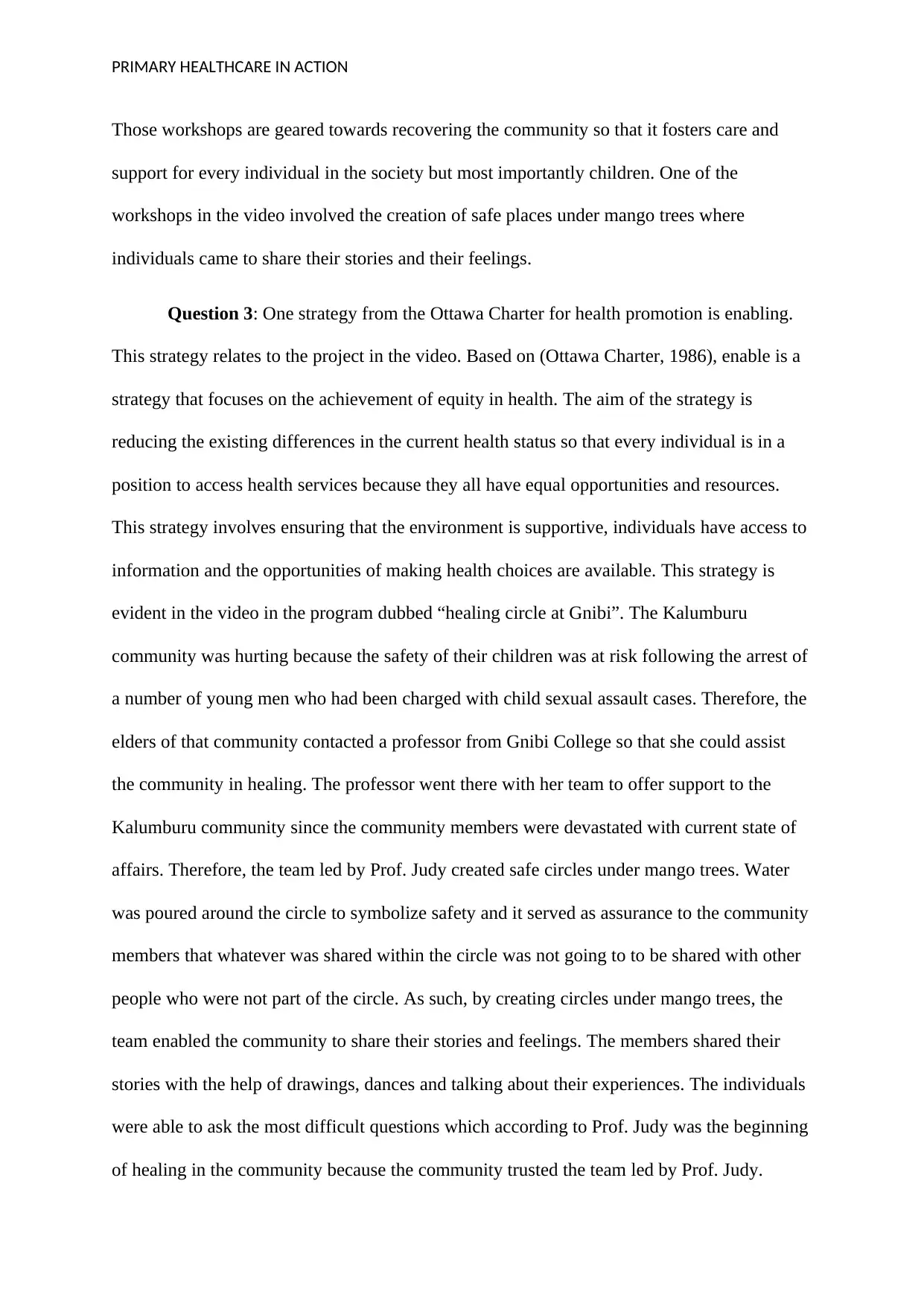
PRIMARY HEALTHCARE IN ACTION
Those workshops are geared towards recovering the community so that it fosters care and
support for every individual in the society but most importantly children. One of the
workshops in the video involved the creation of safe places under mango trees where
individuals came to share their stories and their feelings.
Question 3: One strategy from the Ottawa Charter for health promotion is enabling.
This strategy relates to the project in the video. Based on (Ottawa Charter, 1986), enable is a
strategy that focuses on the achievement of equity in health. The aim of the strategy is
reducing the existing differences in the current health status so that every individual is in a
position to access health services because they all have equal opportunities and resources.
This strategy involves ensuring that the environment is supportive, individuals have access to
information and the opportunities of making health choices are available. This strategy is
evident in the video in the program dubbed “healing circle at Gnibi”. The Kalumburu
community was hurting because the safety of their children was at risk following the arrest of
a number of young men who had been charged with child sexual assault cases. Therefore, the
elders of that community contacted a professor from Gnibi College so that she could assist
the community in healing. The professor went there with her team to offer support to the
Kalumburu community since the community members were devastated with current state of
affairs. Therefore, the team led by Prof. Judy created safe circles under mango trees. Water
was poured around the circle to symbolize safety and it served as assurance to the community
members that whatever was shared within the circle was not going to to be shared with other
people who were not part of the circle. As such, by creating circles under mango trees, the
team enabled the community to share their stories and feelings. The members shared their
stories with the help of drawings, dances and talking about their experiences. The individuals
were able to ask the most difficult questions which according to Prof. Judy was the beginning
of healing in the community because the community trusted the team led by Prof. Judy.
Those workshops are geared towards recovering the community so that it fosters care and
support for every individual in the society but most importantly children. One of the
workshops in the video involved the creation of safe places under mango trees where
individuals came to share their stories and their feelings.
Question 3: One strategy from the Ottawa Charter for health promotion is enabling.
This strategy relates to the project in the video. Based on (Ottawa Charter, 1986), enable is a
strategy that focuses on the achievement of equity in health. The aim of the strategy is
reducing the existing differences in the current health status so that every individual is in a
position to access health services because they all have equal opportunities and resources.
This strategy involves ensuring that the environment is supportive, individuals have access to
information and the opportunities of making health choices are available. This strategy is
evident in the video in the program dubbed “healing circle at Gnibi”. The Kalumburu
community was hurting because the safety of their children was at risk following the arrest of
a number of young men who had been charged with child sexual assault cases. Therefore, the
elders of that community contacted a professor from Gnibi College so that she could assist
the community in healing. The professor went there with her team to offer support to the
Kalumburu community since the community members were devastated with current state of
affairs. Therefore, the team led by Prof. Judy created safe circles under mango trees. Water
was poured around the circle to symbolize safety and it served as assurance to the community
members that whatever was shared within the circle was not going to to be shared with other
people who were not part of the circle. As such, by creating circles under mango trees, the
team enabled the community to share their stories and feelings. The members shared their
stories with the help of drawings, dances and talking about their experiences. The individuals
were able to ask the most difficult questions which according to Prof. Judy was the beginning
of healing in the community because the community trusted the team led by Prof. Judy.
Paraphrase This Document
Need a fresh take? Get an instant paraphrase of this document with our AI Paraphraser
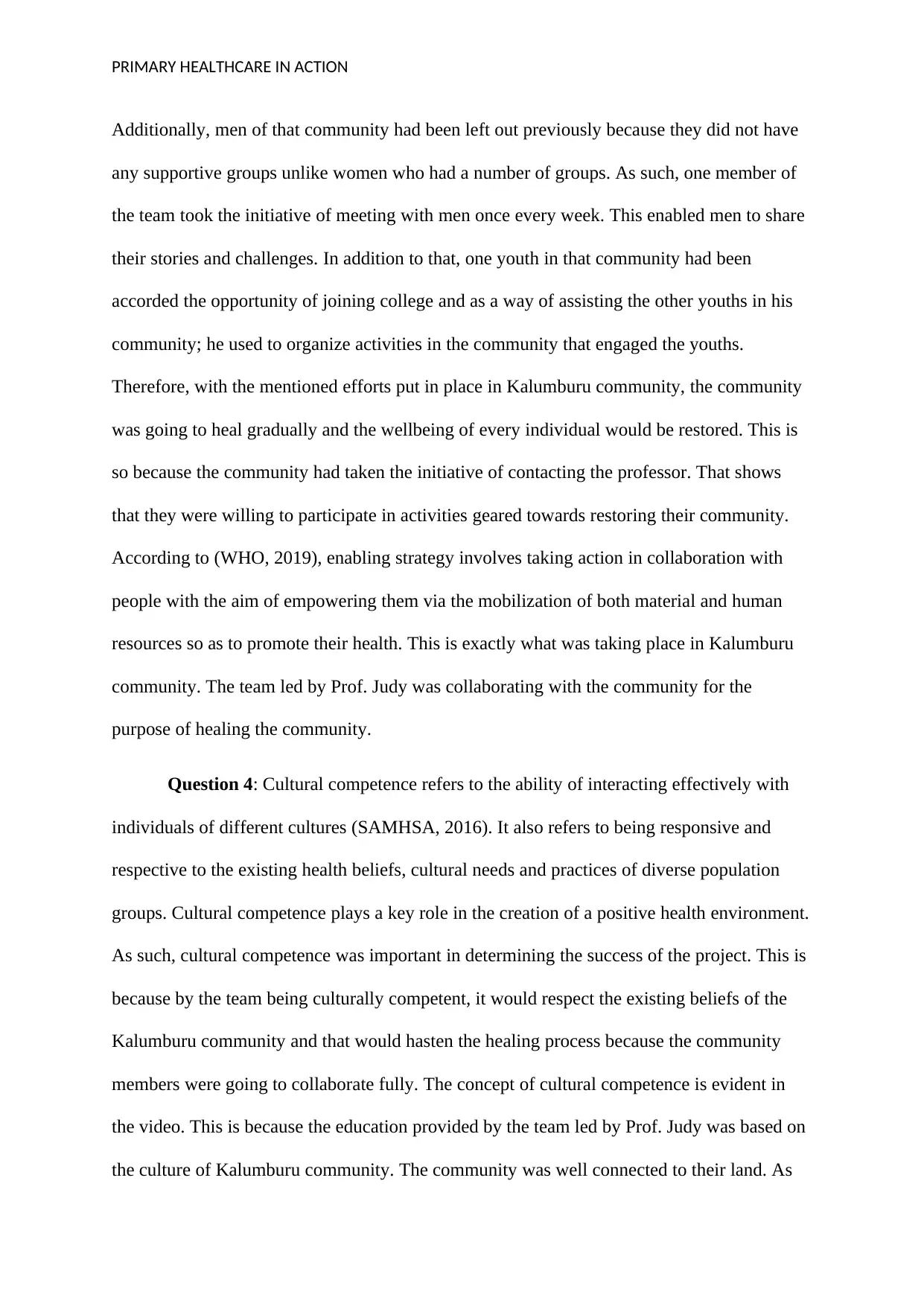
PRIMARY HEALTHCARE IN ACTION
Additionally, men of that community had been left out previously because they did not have
any supportive groups unlike women who had a number of groups. As such, one member of
the team took the initiative of meeting with men once every week. This enabled men to share
their stories and challenges. In addition to that, one youth in that community had been
accorded the opportunity of joining college and as a way of assisting the other youths in his
community; he used to organize activities in the community that engaged the youths.
Therefore, with the mentioned efforts put in place in Kalumburu community, the community
was going to heal gradually and the wellbeing of every individual would be restored. This is
so because the community had taken the initiative of contacting the professor. That shows
that they were willing to participate in activities geared towards restoring their community.
According to (WHO, 2019), enabling strategy involves taking action in collaboration with
people with the aim of empowering them via the mobilization of both material and human
resources so as to promote their health. This is exactly what was taking place in Kalumburu
community. The team led by Prof. Judy was collaborating with the community for the
purpose of healing the community.
Question 4: Cultural competence refers to the ability of interacting effectively with
individuals of different cultures (SAMHSA, 2016). It also refers to being responsive and
respective to the existing health beliefs, cultural needs and practices of diverse population
groups. Cultural competence plays a key role in the creation of a positive health environment.
As such, cultural competence was important in determining the success of the project. This is
because by the team being culturally competent, it would respect the existing beliefs of the
Kalumburu community and that would hasten the healing process because the community
members were going to collaborate fully. The concept of cultural competence is evident in
the video. This is because the education provided by the team led by Prof. Judy was based on
the culture of Kalumburu community. The community was well connected to their land. As
Additionally, men of that community had been left out previously because they did not have
any supportive groups unlike women who had a number of groups. As such, one member of
the team took the initiative of meeting with men once every week. This enabled men to share
their stories and challenges. In addition to that, one youth in that community had been
accorded the opportunity of joining college and as a way of assisting the other youths in his
community; he used to organize activities in the community that engaged the youths.
Therefore, with the mentioned efforts put in place in Kalumburu community, the community
was going to heal gradually and the wellbeing of every individual would be restored. This is
so because the community had taken the initiative of contacting the professor. That shows
that they were willing to participate in activities geared towards restoring their community.
According to (WHO, 2019), enabling strategy involves taking action in collaboration with
people with the aim of empowering them via the mobilization of both material and human
resources so as to promote their health. This is exactly what was taking place in Kalumburu
community. The team led by Prof. Judy was collaborating with the community for the
purpose of healing the community.
Question 4: Cultural competence refers to the ability of interacting effectively with
individuals of different cultures (SAMHSA, 2016). It also refers to being responsive and
respective to the existing health beliefs, cultural needs and practices of diverse population
groups. Cultural competence plays a key role in the creation of a positive health environment.
As such, cultural competence was important in determining the success of the project. This is
because by the team being culturally competent, it would respect the existing beliefs of the
Kalumburu community and that would hasten the healing process because the community
members were going to collaborate fully. The concept of cultural competence is evident in
the video. This is because the education provided by the team led by Prof. Judy was based on
the culture of Kalumburu community. The community was well connected to their land. As
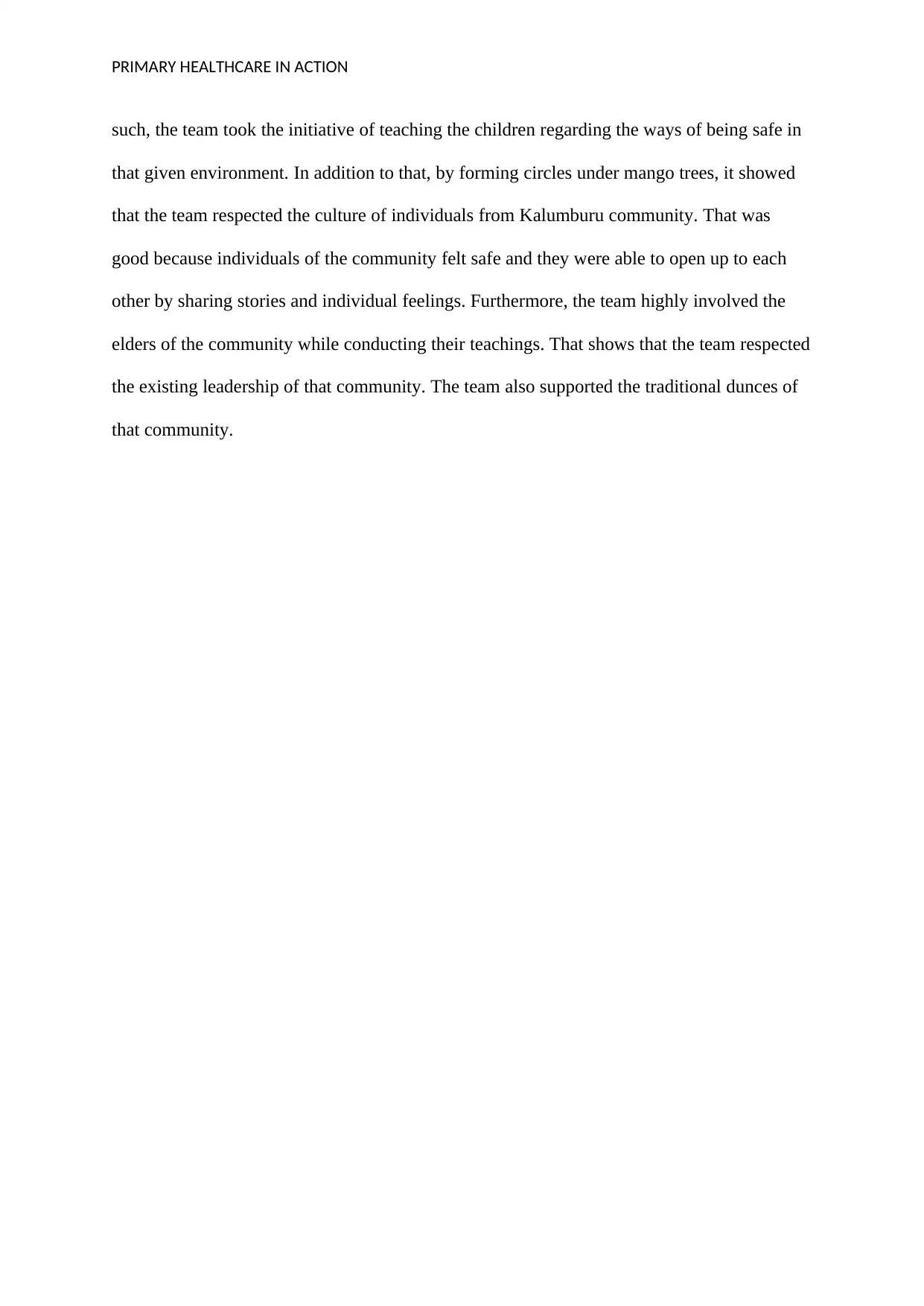
PRIMARY HEALTHCARE IN ACTION
such, the team took the initiative of teaching the children regarding the ways of being safe in
that given environment. In addition to that, by forming circles under mango trees, it showed
that the team respected the culture of individuals from Kalumburu community. That was
good because individuals of the community felt safe and they were able to open up to each
other by sharing stories and individual feelings. Furthermore, the team highly involved the
elders of the community while conducting their teachings. That shows that the team respected
the existing leadership of that community. The team also supported the traditional dunces of
that community.
such, the team took the initiative of teaching the children regarding the ways of being safe in
that given environment. In addition to that, by forming circles under mango trees, it showed
that the team respected the culture of individuals from Kalumburu community. That was
good because individuals of the community felt safe and they were able to open up to each
other by sharing stories and individual feelings. Furthermore, the team highly involved the
elders of the community while conducting their teachings. That shows that the team respected
the existing leadership of that community. The team also supported the traditional dunces of
that community.
⊘ This is a preview!⊘
Do you want full access?
Subscribe today to unlock all pages.

Trusted by 1+ million students worldwide
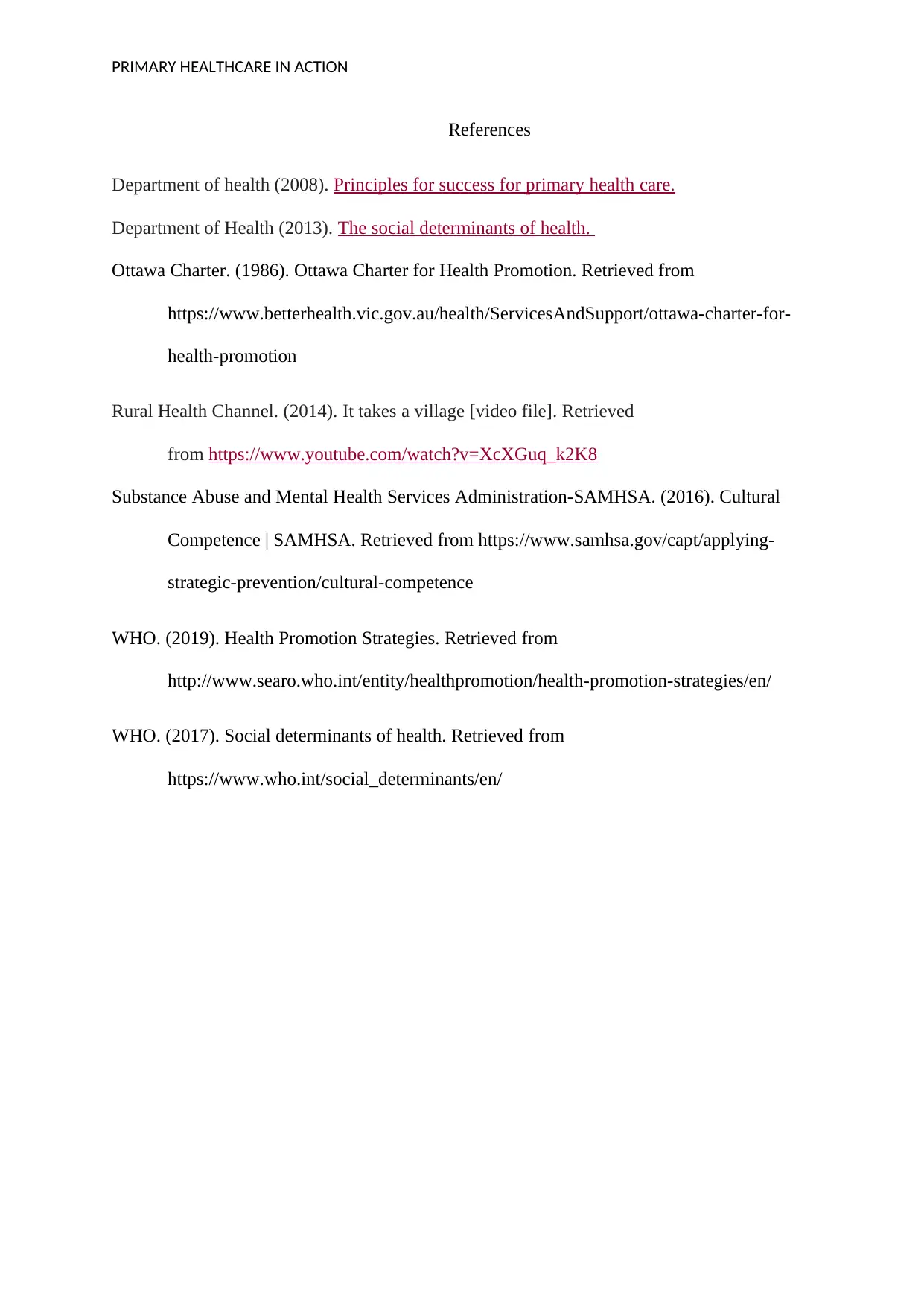
PRIMARY HEALTHCARE IN ACTION
References
Department of health (2008). Principles for success for primary health care.
Department of Health (2013). The social determinants of health.
Ottawa Charter. (1986). Ottawa Charter for Health Promotion. Retrieved from
https://www.betterhealth.vic.gov.au/health/ServicesAndSupport/ottawa-charter-for-
health-promotion
Rural Health Channel. (2014). It takes a village [video file]. Retrieved
from https://www.youtube.com/watch?v=XcXGuq_k2K8
Substance Abuse and Mental Health Services Administration-SAMHSA. (2016). Cultural
Competence | SAMHSA. Retrieved from https://www.samhsa.gov/capt/applying-
strategic-prevention/cultural-competence
WHO. (2019). Health Promotion Strategies. Retrieved from
http://www.searo.who.int/entity/healthpromotion/health-promotion-strategies/en/
WHO. (2017). Social determinants of health. Retrieved from
https://www.who.int/social_determinants/en/
References
Department of health (2008). Principles for success for primary health care.
Department of Health (2013). The social determinants of health.
Ottawa Charter. (1986). Ottawa Charter for Health Promotion. Retrieved from
https://www.betterhealth.vic.gov.au/health/ServicesAndSupport/ottawa-charter-for-
health-promotion
Rural Health Channel. (2014). It takes a village [video file]. Retrieved
from https://www.youtube.com/watch?v=XcXGuq_k2K8
Substance Abuse and Mental Health Services Administration-SAMHSA. (2016). Cultural
Competence | SAMHSA. Retrieved from https://www.samhsa.gov/capt/applying-
strategic-prevention/cultural-competence
WHO. (2019). Health Promotion Strategies. Retrieved from
http://www.searo.who.int/entity/healthpromotion/health-promotion-strategies/en/
WHO. (2017). Social determinants of health. Retrieved from
https://www.who.int/social_determinants/en/
1 out of 7
Related Documents
Your All-in-One AI-Powered Toolkit for Academic Success.
+13062052269
info@desklib.com
Available 24*7 on WhatsApp / Email
![[object Object]](/_next/static/media/star-bottom.7253800d.svg)
Unlock your academic potential
Copyright © 2020–2025 A2Z Services. All Rights Reserved. Developed and managed by ZUCOL.




